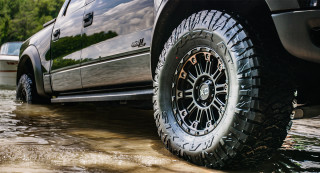What to look for when buying 4x4 tyres
Choosing the right tyres for the job will make all the difference to how far your 4x4 can go... and how enjoyable it is on the way. Here's some key points to consider:
First up: The tread design
They're all good at different things, and some these days are quite good at most things.
All Terrain
If you’re doing a majority of highway driving with a a bit of off-road here and there, a good All Terrain tyre will take you a long way. The best All Terrain tyres drive and handle similarly to a highway tyre, so look for siped tread blocks which will mean better grip on wet roads, and ask about the tyre’s road noise and handling.
Mud Traction
If you're more into serious mud grip, look for tapered tread lugs (i.e. the voids between the tread lugs are wider at the edge of the tyre than further in) to allow the tyre to spit out mud. Also check the tread voids for ribs or bumps as these help to expel mud and stones. But unless you never leave the mud pits, make sure you also ask about the tyre's highway performance. Well-designed mud tyres these days are a pleasure to drive on the road.
Highway
If you're only on the highway, you might want to opt for a highway pattern, or you might want something that dresses up the ute a bit more. But if you opt for the latter, we do seriously recommend you choose an All Terrain or Mud Tyre that has a reputation for good road handling and quietness - or your travels could get a little fatiguing.

The construction:
Some tyre manufacturers simply add more bulk, others build in layers of puncture resistant material such as a nylon ply. Extra bulk can in some constructions mean more punctures as it tends to make the tyre less likely to flex over obstacles. Ask how puncture-resistant the tyre will be, specially if you drive on gravel or rough roads.
The load rating:
4x4 tyres can be rated to carry anything between 850 kg and 1800 kg per tyre, so ask about the load ratings of the tyres you’re looking at and make sure they’re appropriate for your needs.
If you’re regularly towing or carrying loads you need to make sure you have the load capacity to handle it as you'll otherwise end up with fast wearing tyres and a risk of premature tyre failure.
If you don’t need the extra load capacity however, you’ll likely get a better ride, better braking and longer wear with a tyre designed for lighter loads.
Should you want to look up the load rating of the tyres you're considering, we have a handy table of load and speed indexes here.

The tyre's wet road performance:
Again, we can’t emphasise this enough because almost all 4x4 drivers find themselves doing some highway running and the difference between different tyre designs can be huge. Again look for siping - tiny grooves in the tread lugs that help to expel water – and ask about the tyre’s road noise and wet road handling.
And then...
One more tip: make sure you check the spare as well, particularly if you've changed from your original tyre size, as there's nothing worse than being stuck on the roadside with a spare that doesn't fit or isn't suitable to use. Then you should be good to go with your new 4x4 tyres. Make sure you take them exploring and make the best of all the places they can get you to!